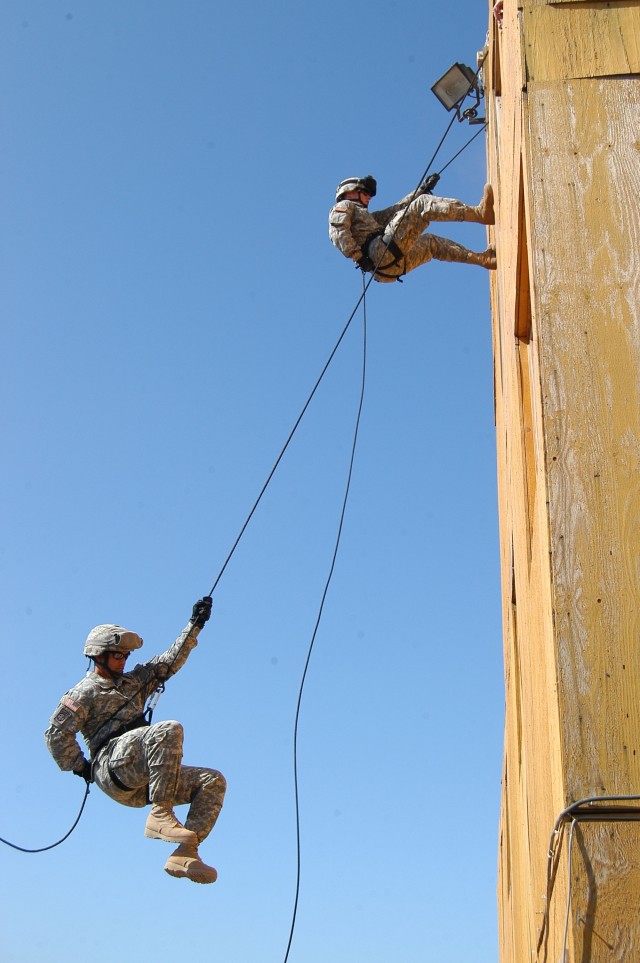CAMP LEMONIER, Djibouti (Army News Service, Jan. 9, 2008) -- Soldiers deployed from Fort Myer, Va., gained confidence in a rappelling training session conducted by Combined Joint Task Force-Horn of Africa Explosive Ordnance Disposal Mobile Unit 8 Det. 20, Jan. 4.
"As light infantrymen, we are expected to insert by air, ground or water to close within, engage and destroy the enemy," said Sgt. 1st Class Jimmy E. Inabinet, D Company, 1st Battalion, 3rd U.S. Infantry Regiment. "Air assault operations play a big part in the current types of combat overseas. Rappelling is just one aspect of the tactics associated with air assault."
Some Soldiers in the "Old Guard" company already have experience in rappelling. But the group consisted largely of beginners.
"The purpose of the training was a refresher course for some Soldiers, but it served mainly as an introduction to the many facets of insertion that infantrymen are capable of conducting," said Sgt. Inabinet.
Infantry units are trained in a broad spectrum of skills due to their missions. Rappelling is one of those.
"This skill can be used by infantrymen to enter a building from a roof into an upper floor," said 1st Sgt. Anthony E. Chavez, D Company, 1st Battalion, 3rd U.S. Infantry Regiment first sergeant. "It's also used to insert infantrymen in an area when helicopters cannot land. This gives Soldiers an opportunity to learn and practice a skill that we do not normally have the opportunity to use at our home station."
Rappelling falls into one of three categories that enhance an infantryman's skill set.
"In order to be effective, infantry units must be able to shoot, move and communicate in many different environments and on all types of terrain. Rappelling falls into the move category of skills," said Maj. Edward S. Twaddell III, D Company, 1st Battalion, 3rd U.S. Infantry Regiment company commander.
Navy Chief Petty Officer Melissa A. Tackitt, CJTF-HOA EOD Mobile Unit 8 Detachment 20 master technician was one of two Sailors who trained the Soldiers.
The EOD technicians worked with the Soldiers to ensure they qualified to rappel out of a helicopter.
"It's important to make sure they have a good clearance on the first push out the door or ramp," said Chief Petty Officer Tackitt. "If you cut yourself short, you increase your chances of smacking the bottom side of the helo. You must also maintain your speed and be aware of the helo's actions while you are rappelling down in case of an emergency situation."
Part of the rappel training included the Soldiers learning how to lock out, which is considered the most difficult portion of the training. It's a safety procedure taught to rappellers to keep from declining. The technique is used by Soldiers if rappelling out of a helicopter that has to make a sudden move.
"Since EOD1 Demetrius S. O'Halloran and I have been in Djibouti, we have qualified numerous people on the skills of Helicopter Rope Suspension Training and rappelling," said Chief Petty Officer Tackitt. "We enjoy it, and it allows us to be that much more proficient in our HRST master skills."
After accomplishing the lock out technique, the Soldiers are now qualified to rappel out of helicopters.
"The Old Guard did wonderful," said Chief Petty Officer Tackitt. "They were very dedicated to ensuring all of their members were capable of locking out, which is a procedure that allows a rappeller to stay on the line in case of an emergency."
With the assistance of sister services as well as coalition forces, Soldiers in D Company have undergone the Desert and Survival French Commando Course, Urban Warfare training using simmunition rounds and now HRST.
"The training we have conducted with EOD, Marine Heavy Helicopter Squadron 464 and French military has been a great way for our Soldiers to interact with servicemembers from the different military branches and countries," said 1st Sgt. Chavez. "The learning goes both ways and all involved grow professionally with new skills."
The Old Guard, EOD and HMH-464 are serving under the CJTF-HOA mission to prevent conflict, promote regional stability and protect coalition interest in order to prevail against extremism.




Social Sharing